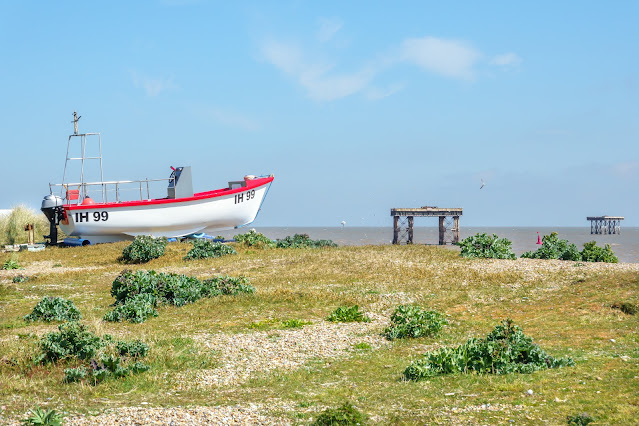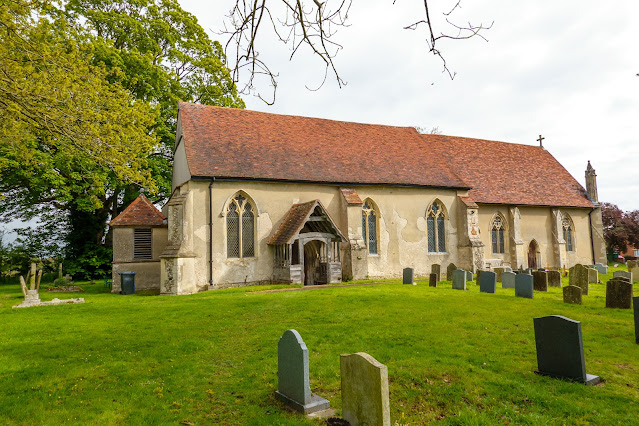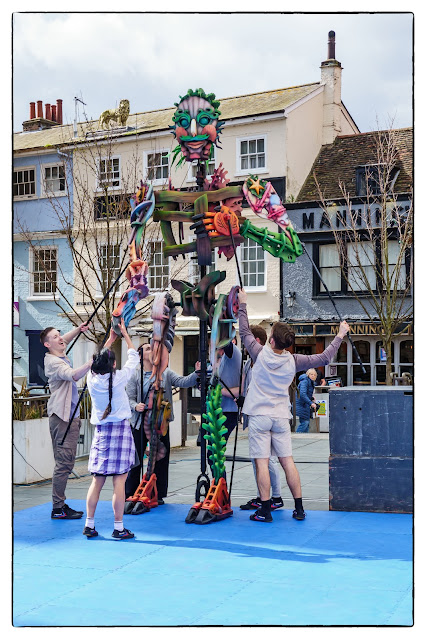Having made several journeys along this route, this was my day to visit the three churches that I have passed by each time. Starting with Shottisham. This is a rather pretty village which I had not visited before although I have driven past it. Having parked the car, I was warned, twice, by an elderly gentleman (older than me!) to take care climbing the steps to the church and to hang on to the railing. Bless him.
My first view of the church was this - once I had navigated the steps:
The church is dedicated to St Margaret of Antioch, a rather unusual dedication I thought, and was built in 1313 by the monks of Butley Abbey. There are signs that there was an earlier church building.
In 1969 Margaret’s feast day, formerly July 20, was eliminated in the revised calendar of the Roman Catholic Church because it is doubtful whether she ever existed. Nevertheless, during the medieval period she ranked among the most famous saints; her voice was among those attested to have been heard by St. Joan of Arc.
The East, Chancel end, of the church showing the North Aisle added in 1867 when the church was enlarged.
Another external view of the North Aisle
I think this may have been the Priest`s door.
The south porch
I was rather taken by the interior which I thought was rather lovely. I think the lights really set off the building. Note on the right the Rood Stair which would originally have led to the Rood Screen. Probably, like most screens, a casuallty of the Puritans in the 1600s. The East windows are Victorian.
Alderton and the church of St Andrew
Then onto Alderton just a few minutes away, and the first thing you see is - no tower! The tower, once a seamark, collapsed under its own weight during the 17/18th century and fell further in 1821. I thought it must have been in more modern time, but not so. This is another of the many `Victorianised `churches in Suffolk - they really `went to town` here!
Alderton Church of St Andrew.
The Church bell now hangs just outside the tower.
Love this door. Think it was on the South side.
The original Medieval font has not survived and this one was carved in the 1860`s
The rather plain interior.
Unusually, just a small harmonium instead of the grand affairs often found.
They may have no tower but the interior ceiling looks recently replaced, although it may be a lot older than I think.
Finally onto Bawdsey and the church of St Mary

This building is very much a miss-match of earlier buildings! The remains of the medieval church are set in the 17th century walls. The arcades were filled in with flint and brick, and the clerestorey broken down and replaced by a brick course. The church was a grand perpendicular affair, in the manner of Blythburgh, Covehithe or Southwold. However, like Covehithe, it was allowed to become derelict after the Reformation, and a new, smaller church built in the ruins, probably in the late 17th century. Remarkably, the former arcades were infilled for the walls, and you can still see them in the outside walls in the above image. The tower was in danger of collapse, and in the 1820s, the tiles of the church roof were replaced by thatch, to stop bits of stone breaking the tiles (it is hard to think of this as anything other than a short term measure.) Unfortunately, when a group of youths set off fireworks from the top of the tower on Guy Fawkes Night 1841, the thatch caught fire, and the church was completely gutted. The rebuilt church is basically a Victorian chapel with 17th century walls, a truncated tower (about two thirds was removed)

Bawdsey's story pivots around a man called William Cuthbert Quilter, whose family had amassed a fortune. They rented Hintlesham Hall in Suffolk for ten years in the 1880s, and then bought, at auction, the manordom of Bawdsey. As Lord, he built Bawdsey Manor between 1886 and 1910. Sir Cuthbert (as he now was) had been MP for Ipswich since the 1880s. He was, apparently, a man obsessed by real ale, and the only time he stood up in the house to speak it was on the subject of the purity of beer. He built up a number of independent Suffolk breweries, which, in the 1950s, were conveniently bought up lock, stock and barrel by the Cobbolds, who not unnaturally closed them all down.



Sir Cuthbert had such a high opinion of himself and his family that he built this grand mausoleum in Bawdsey churchyard. You step out of the west door of the church, and climb some steps to a vast chest tomb, with family names on it. Beyond that, more steps rise to an urn. His family's names are inscribed on it. This is interesting, because one of his sons grew up to be the composer Roger Quilter, one of the finest songwriters of the early 20th century, and along with Peter Warlock, was part of that English generation before Benjamin Britten. But Roger Quilter wasn't born in Suffolk, and he never lived in Bawdsey.
Unsurprisingly, the church has a special place in its heart for the RAF, who were based at Bawdsey manor during the Second World War and for a number of years afterwards. The Union flag and RAF banner in the chancel.
The church contains another memory of an even more famous person, who not only wasn't born in Suffolk and never lived here, she isn't buried here either. This is Nurse Edith Cavell, shot in Belgium in 1916. The memorial to her great-uncle and great-aunt remembers her as well, with a framed account of her story hanging below their simple wall plaque.















%20in%20Snape%20Church03.JPG)
%20in%20Snape%20Church01.JPG)



































